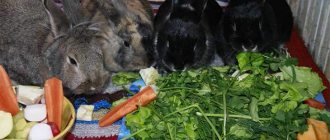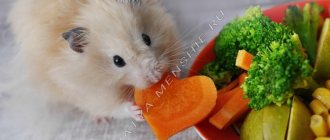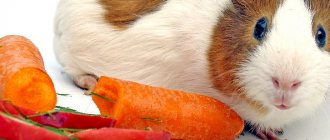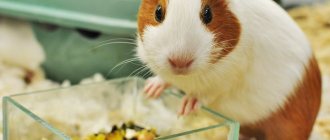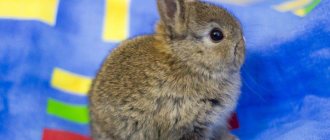The basis of rabbit nutrition is hay, but the diet will not be complete without succulent feed. The menu of lagomorphs must necessarily contain vegetables, herbs and fruits. But when introducing these products, you need to monitor the reaction of the animal’s body.
Let's find out whether rabbits can eat potatoes and other vegetables, what their daily dosage is and the recommended method of preparation.
Potatoes for rabbits
It is impossible to say for sure whether rabbits can be given potatoes. This depends on the condition of the product, how it is prepared and what part of it is used for feeding.
Potatoes for rabbits should be ripe, clean, without sprouts, and the skin should be light brown.
Important! It is forbidden to feed your pets green potatoes, as they contain solanine. This toxic organic compound leads to intoxication.
Potatoes are suitable to supplement the diet. Raw or cooked product is used to feed rabbits. They love to eat fresh potatoes, but the vegetable is easier to digest after boiling.
Potato tops are not suitable to supplement the diet of animals, as they contain toxic substances. Cleaning is also not recommended, as they are quite rough and contain chemicals and fungi.
Raw
Raw potatoes are rich in ascorbic acid, B vitamins, and minerals. However, it contains a lot of starch, which is poorly digestible.
The amount of potatoes should not be more than 10% of the daily diet. As this dose increases, the risk of digestive disorders (nausea, bloating, heartburn, and sometimes diarrhea and vomiting) increases.
Raw root vegetables are introduced into the rabbit menu no earlier than 4 months.
Interesting! Meat breed rabbits are not given fresh potatoes, as they are slaughtered 3–4 months after birth. Before this age, this product is contraindicated.
Pregnant and lactating females are also prohibited from feeding raw potatoes. This is because the starch in root vegetables often leads to clogged milk ducts. For this reason, this product is not suitable for breeding females.
Raw potatoes are not suitable for males, as they lead to digestive disorders. Their health is fragile, so it is better not to take risks and refuse this product.
It is not advisable to feed raw potatoes to downy rabbits. The quality of fur improves under the influence of protein, which is missing in this product.
In all other cases, you can feed your rabbits raw potatoes. Before serving, the vegetable must be peeled, washed, and cut into small pieces. The animals get used to the product gradually. They are more willing to eat it in winter, when there is not enough fresh, succulent food in their diet.
After the first tasting of potatoes, you need to monitor the condition of the animal. If symptoms of intolerance to the product appear (gastritis, irritable bowel syndrome, urticaria), it should be excluded from the diet.
Is it possible to give boiled potatoes to rabbits?
After cooking (20–30 minutes), potatoes become a complete component of the diet. It is easier to digest, accelerates weight gain, and does not overload the gastrointestinal tract. Therefore, boiled potatoes should be given to meat rabbits during the fattening period.
Important! The content of boiled potatoes is 40–60% of the daily diet, that is, no more than 200 g of product per day. They are supplemented with mixtures for pregnant and lactating females. Rabbits are also allowed to eat boiled potatoes.
You should not give boiled fruits to breeding individuals a week before mating. If their weight is slightly higher than normal, then the desire to mate will decrease and the number of offspring will decrease.
Owners independently decide whether to introduce boiled potatoes into the diet. This largely depends on the lifestyle of the pets. If rabbits live in a cramped cage and are passive, then the product norm is in the range of 50–70 g per day. At the first symptoms of obesity, this portion must be reduced. If the pet often walks outside the cage, then the product rate increases to 80–100 g per day. That is, 1 medium potato is enough for the animal.
For feeding, boiled potatoes, their peels or mashed pulp are used. The main thing is that the product is fresh.
Before cooking, the fruits are cleaned of sprouts and green areas and washed thoroughly.
Lagomorphs digest potatoes best in the evening. But it is better to give the product crushed with water, rather than whole. Rabbits love mash of potatoes, feed, grains and herbs:
- 50% boiled potatoes, 45% mixed feed, 5% chopped cabbage or nettles, which must be doused with boiling water;
- 50% potatoes, 40% steamed grains (oats, corn, barley), 8% boiled peas, 2% greens (shredded cabbage).
A mash of potatoes for pregnant females is sprinkled with chopped parsley. Such food promotes milk flow. 7 days before weaning the rabbits from their mother, dill is added to the mixture. This will help stop lactation faster.
Potato tops and peelings
The leaves of root vegetables contain harmful substances after insecticidal spraying, so they should not be given to rabbits. Solanine accumulates in the tops and sprouts, which causes intoxication.
Raw or boiled potato peelings are used to feed lagomorphs. They must be clean and unspoiled.
Flour is made from potato peelings. To do this, the raw materials are steamed with boiling water, dried, and ground. The finished powder is mixed with food. The product in this form retains more nutrients and is stored longer.
The optimal portion of potato peelings is 10% of the daily dose. If the norm is exceeded, the rabbit quickly gains weight.
Feeding baby rabbits
Little rabbits are fed by the mother rabbit for up to three weeks, after which they begin to become interested in hay and feed, following the example of their mother. At three months, vegetables are gradually introduced. Accustoming to different types of vegetables occurs alternately.
For the health of small and adult pets, the gradual introduction of new foods is very important; they should not be given two new types of foods at once.
From seven months to a year, animals are given hay, herbs, vegetables, and mixed feed (a tablespoon three times a day).
Fresh grass for rabbits is the basis of the diet
Rabbits one year of age and older should always have hay in their feeder.
Changes in the diet of one-year-old pets concern only compound feed, which is given twice a day in two ways:
- one and a half to two tablespoons in the morning and evening;
- one spoon in the morning and three in the evening.
It is very important to monitor the amount of food consumed. Young rabbits are prone to obesity!
At the first signs of excess weight, the amount of feed should be reduced. Vegetables, grass and greens can be given constantly. If by the evening there is a lot left uneaten, you should reduce the portion. Food should always be fresh, free from mold and nitrous.
Is it possible to feed rabbits beets?
In Russia, 3 types of crops are grown: table crops, fodder crops, and sugar crops. Only 2 of them can be used to feed animals.
Table beets should not be given to lagomorphs. This is due to the fact that this variety of vegetable negatively affects the stomach and intestines due to its high fiber content, as well as organic acids. Red beets are not suitable for rabbits, as they cause diarrhea, interfere with the absorption of calcium, and if consumed in moderation, increases the risk of their death.
Inexperienced owners of lagomorphs do not always know for sure whether it is possible to give red beets and raw potatoes to rabbits. This mixture will definitely harm the health of the animals, so it is better to choose a different variety of beets and boil the potatoes.
Rabbits can be given fodder and sugar beets, as they are rich in nutrients and are easier to digest than table beets. The animals eat all parts of the vegetable crop: roots, tops, leaves.
When feeding lagomorphs with beets, the following recommendations should be followed:
- The animals eat the vegetable raw or boiled.
- For the first tasting, boiled beets in a small portion are suitable; its quantity should be increased gradually in the absence of negative reactions.
- Before serving, the tops must be carefully examined and rotten or limp twigs and leaves removed. The raw materials should be washed, doused with boiling water, and cut into medium-sized pieces.
- The tops are mixed with grass, branches and other food.
After harvesting, root vegetables must be dried under a canopy or in another room with good ventilation and protection from rain. They are laid out on a tarpaulin in one layer and left for 24 hours. Then the vegetables are sorted: the spoiled ones are used first, and the good ones are sent for storage in the cellar.
Before use, beets with areas of rot are washed and the affected areas are removed. You cannot store them, as they will completely disappear.
Sugar or fodder beets can be given to rabbits from 4 weeks after birth. The initial dose should not exceed 25 g per day, this portion can be increased over time. Boiled vegetables are more suitable for children. A week after introduction into the diet, young animals are given raw or dried beets as part of feed mixtures or with silage.
2 months after birth, the daily norm of root vegetables increases to 100 g. At 3–4 months of life, rabbits are given 150 g of beets per day. After 4 months, a portion of the vegetable is 250 g.
Interesting! If rabbits are accustomed to beets from childhood, then adults will be able to eat about 500 g of the vegetable without harm to their health. Otherwise, they will suffer from digestive disorders.
Beetroot complementary foods are introduced into the diet of pregnant females only if they have been accustomed to the vegetable since childhood. The optimal daily dose does not exceed 450 g (100–150 g three times a day). Tops are suitable for feeding rabbits, but are slightly withered. The daily intake of this product is up to 450 g. It is believed that beets increase lactation.
Greenery
It is a subtype of succulent feed available in the summer. Has a high content of protein and vitamins. The lack of greens in the diet can lead to sad consequences: decreased reproductive function and lactation in females, slowed growth of newborns. Greens should be introduced gradually after winter. Rabbits welcome any garden greens:
- parsley;
- dill;
- salad;
- basil;
- celery;
- mint.
Such herbs contain a lot of calcium and trace elements. You can include wild plants in your diet: clover, burdock, wheatgrass, alfalfa, dandelions, tansy. It is important to alternate plants. Greens should be given dried.
How to give fodder beets to rabbits
New rabbit owners should have no doubt about whether their rabbits can be given fodder beets. Animals will happily feast on the juicy pulp, which is rich in nutrients. Carbohydrates accelerate weight gain, which is especially important for owners of meat breeds.
Baby rabbits are given beets from 4 weeks after birth.
At first, the animals are fed boiled root vegetables, which are often mixed with other food (potatoes, greens). Red beets are also used to make silage:
- Chopped green legumes are poured into the bottom of a large barrel.
- The second layer is the peel of potatoes, carrots and other vegetables.
- The third layer is chopped beets (tops, root vegetables).
- The rest of the barrel space is filled with sawdust.
- The top of the container is covered with clay.
In winter, this silage is given to rabbits as a vitamin supplement, which strengthens the immune system.
Sugar
Rabbits enjoy eating sugar beets as they contain a lot of sugar. The root vegetable contains ascorbic acid, group B elements, pectin and other substances that are necessary for the normal functioning of the cardiovascular system. The amount of fiber in the vegetable is small, which is good for lagomorphs. Therefore, sugar beets are healthy, tasty, and also easily digestible by the animals.
With regular use, it increases hemoglobin levels, strengthens the immune system, and normalizes digestion.
Rabbits eat raw and boiled beets (the second option is better digestible). The optimal portion of the product is 300 g.
Beet tops
Beetroot leaves and stems are not given fresh; they need to be dried in the sun. After eating juicy greens, flatulence and diarrhea occur.
Chopped beet tops are given to rabbits as feed, mixed with other food (vegetables, hay, grass, one of the components of silage).
The greens are cut with a small base from the beets, sorted, damaged leaves are removed, dirt and insects are washed off. The tops are connected in groups of 3 and hung in a darkened room with good ventilation.
Before serving, the tops are usually chopped and then mixed with feed. It is advisable to steam the raw material, then it will be easier to digest.
Special treats for grinding teeth
First of all, branches will contribute to this. The following trees are suitable for this:
- birch;
- aspen;
- oak;
- willow;
- poplar;
- Apple tree;
- pear.
Solid foods wear down ever-growing teeth. Occasionally, crackers made from white bread can be given for this purpose. In addition, there are special grain sticks available for sale. They contain a large number of microelements. For animals this is a long-awaited treat.
Can rabbits have cabbage?
Not all varieties of vegetables are used for feeding. In addition, you should follow the daily norm.
Rabbits can be given white cabbage as complementary food. It is rich in minerals, ascorbic acid, vitamin E. These substances improve the condition of the coat.
The rabbit can be fed boiled cabbage. For feeding, use the top leaves of white cabbage, which are washed and dried a little so that they are dried. Fresh product is not recommended for consumption.
Rabbit owners need to know not only about the benefits, but also the dangers of white cabbage. If consumed excessively, too early or incorrectly, the product causes bloating and diarrhea. The most dangerous are the leaves that grow near the stalk; they should not be given to animals.
Rabbits can be given cauliflower, broccoli, kohlrabi, and Brussels sprouts. However, the amount of vegetable should be limited (up to 100 g per day for an adult rabbit).
Red cabbage causes the greatest harm to the body of rabbits. It should not be included in the diet, as it causes flatulence and increases the risk of gastrointestinal stasis (slowing or stopping gastric motility). The latter disease causes discomfort, abdominal pain, and increases the risk of stomach ulcers and liver degeneration.
Interesting! Cabbage complementary foods are introduced into the diet of rabbits 3.5 months after birth. It is forbidden to use frozen vegetables for feeding.
Rabbits can be given cabbage leaves after fermentation. The product is rich in vitamin C, which improves immunity. It is given to pets instead of lush greens and grass. You should not give animals more than 100–150 g of sauerkraut per day.
Ready-made or natural food
Many rabbit breeders notice that young animals grow well on ready-made (concentrated) feed. Rabbits get sick less and gain weight well. Compound feeds are rich in proteins and contain a lot of proteins, vitamin and mineral components. And all this is balanced according to the weight and age of the animals.
It is convenient to purchase such food at a pet store or from trusted suppliers. But you shouldn’t buy a large batch right away; it’s better to buy a small amount of food and check how much your furry pets like it.
Experts do not recommend feeding adult animals with compound feed every day. Prepared food is offered to decorative rabbits no more than 2 times a day, in small portions. It is best to alternate such formulations with natural nutrition.
For an adult rabbit, 2 tablespoons of ready-made food is enough for a day; a baby needs less - about 1.5 tablespoons. If the animal has not eaten (or has not finished eating) the offered portion of compound feed, such food should no longer be added to its feeder.
Carrot
This vegetable is suitable for feeding rabbits. It is rich in carotene, vitamins C, B, and natural sugars.
Carrot complementary foods can be introduced from the age of 2–3 months. Although the animals love vegetables, they cannot eat much. With an excess of the product, the risk of bloating of the stomach or intestines and other digestive disorders increases.
The animals are given fresh carrots (forage and table varieties), mixed with other silage components, and also pickled or fermented. For the winter, you can pickle root vegetables; to do this, wash them, put them in a barrel, fill them with a water-salt solution (4–5%), and cover them with a lid. In this form, the product can be stored for a whole year.
Carrots are usually given to rabbits as part of mash. Before this, the fruit is peeled, cut into cubes and mixed with other ingredients.
It is recommended to feed carrot tops to rabbits who have recently been ill. It is given dried or dried. It is recommended to combine tops with fresh carrots as part of various feeds.
Useful tips
So that the breeder does not have questions about how to feed a decorative rabbit, we suggest using the advice of professionals:
- pets should receive fresh, high-quality food and clean water, be fed at the same time, and given hay daily,
- dry fresh grass is dried before feeding,
- You cannot collect grass growing along the highways or in dog walking areas,
- Vegetables and fruits for pets need to be washed and cleaned well.
Some features of caring for rabbits
Proper feeding, maintenance and care will give your pet a long and happy life. Animals tolerate twenty-degree cold and heat up to +20, but they do not like stuffiness, overheating and high humidity. Heat exchange in animals occurs through their ears. On particularly hot days, rabbits’ ears are wiped with a cloth moistened with cool water or the cage is covered with a damp towel. You can also place a plastic container with cold water and pieces of ice in the cage.
It's not me! It was they who squabbled!
Any animal needs movement. Owners often let rabbits out for a walk around the apartment, but before that they need to remove everything that can be chewed. First of all, you should take care of the wires.
I just wanted to make a mink!
The rabbit is clean and cleans its own skin. However, many owners wonder whether it is possible to wash their pets. In case of diarrhea and in hot weather, it is allowed to wash decorative rabbits. You can bathe your pet in a basin with special shampoo or regular baby soap. If only the paws and tail are dirty, you can wash the animal under the tap. It is important to remember that the animal’s thick fur takes a long time to dry, which means you should dry the rabbit well after water treatments and make sure that there are no drafts around.
Essential Vitamins and Minerals
As a rule, a lack of vitamins and minerals is observed in rabbits in winter and early spring. There are several vitamin and mineral complexes that are very successfully used by rabbit breeders:
- "Chiktonik" - includes about three dozen vitamins and basic amino acids. The drug is given in five-day courses, every month, at the rate of 1 ml per liter of clean water;
- “Prodevit” is a vitamin complex designed for weakened animals suffering from ulcers, rickets, liver diseases, and pathology of the mucous membranes. The drug is available in injection and oral form;
- “E-Selenium” is a drug intended for the correction of developmental and growth disorders, exacerbation of infectious diseases, treatment of poisoning and other pathologies. Available in injection and oral form.
Mineral supplements represented by mineral stones: “Chika” and Karli have proven themselves very well. You can also use "Bio-iron", supplemented with essential microelements, and the vitamin and mineral supplement "Ushastik".
General nutrition information
Dwarf rabbits eat the same as their larger counterparts. Animals are strict vegans, that is, they eat only plant foods. In nature, they eat herbs and seeds, roots and twigs of shrubs, and fallen leaves. They do not disdain fruits, berries, and some root vegetables that have fallen from trees.
A rodent's teeth and entire digestive system are designed to process rough, fibrous plant foods. A lack of fiber in an animal's diet, if the emphasis is on concentrates, can lead to constipation and other health problems.
Mineral stones
As mineral stones, you can use pieces of chalk, iodized salt, gypsum, as well as special granules that contain microelements necessary for the normal development of animals. The natural composition allows not only to grind down the incisors, but also strengthens the not particularly strong skeleton of these animals, and also helps improve digestion. Thus, abrasive properties are combined with benefits for the body.
For rabbits this is a welcome treat. To ensure that it is always available, mineral stones can be hung on the bars of the cage.
